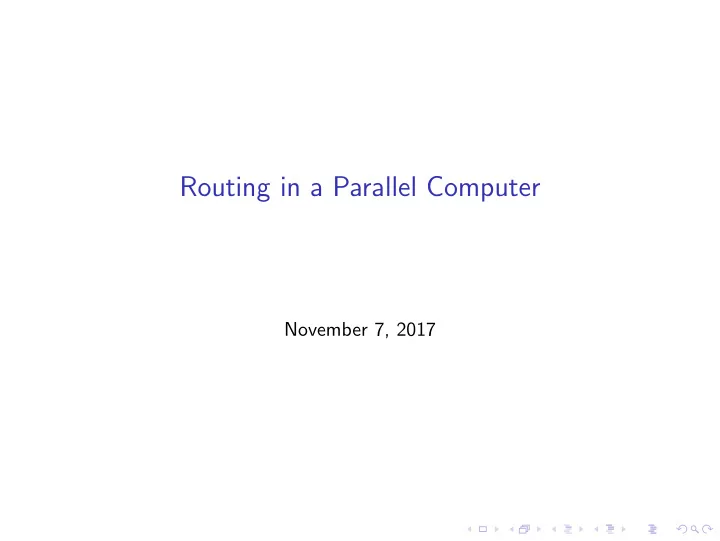

Routing in a Parallel Computer November 7, 2017
Model ◮ model parallel machine as a graph ◮ N nodes ◮ nodes: processing elements ◮ unique identifier in 1 , ..., N ◮ edges: communication links ◮ communication in synchronous steps ◮ in each step, send at most one packet over a link
The Permutation Routing Problem ◮ Each processor initially contains one packet destined for some processor in the network. ◮ Let v i denote the packet originating at processor i . ◮ We denote its destination by d ( i ) . ◮ d ( i ) forms a permutation of { 1 , ..., N } . ◮ How many steps are necessary and sufficient to route an arbitrary permutation request?
Oblivious Algorithms ◮ Oblivious strategy: The route chosen for each packet does not depend on the routes of other packets. ◮ That is, the path from i to d ( i ) is a function of i and d ( i ) only.
Lower Bound Theorem (Theorem 4.4, MR95) For any deterministic oblivious permutation routing algorithm on a network of N nodes each of out-degree d , there is an instance of � permutation routing requiring Ω( N/d ) steps.
Hypercubes ◮ A popular network for parallel processing is the Boolean hypercube. ◮ N = 2 n nodes ◮ connected in the following manner: ◮ Let ( i 0 , ..., i n − 1 ) ∈ { 0 , 1 } n be the (ordered) binary representation of node i ◮ There is a directed edge from node i to node j if and only if their binary representations differ in exactly one position. ◮ Every node in the hypercube has n = log 2 N directed outgoing edges. ◮ Theorem 4.4 then tells us that for any deterministic oblivious routing algorithm on the hypercube, there is a permutation requiring � Ω( N/n ) steps.
The Bit-Fixing Algorithm ◮ source and destination addresses are n -bit vectors ◮ scan the bits of d ( i ) from left to right ◮ compare them with the address of the current location of the packet. ◮ Send the packet along the edge corresponding to the left-most bit in which the current position and d ( i ) differ.
A Randomized Oblivious Algorithm ◮ Phase 1: Pick a random intermediate destination σ ( i ) from { 1 , ..., n } . Packet v i travels to node σ ( i ) . ◮ Phase 2: Packet v i travels from σ ( i ) on to its destination d ( i ) . ◮ Each phase uses the bit-fixing strategy to determine its route. ◮ Nodes use a FIFO queue to store incoming packets.
Analysis ◮ Observation: View each route in Phase 1 as a directed path in the hypercube from the source to the intermediate destination. Once two routes separate, they do not rejoin. Lemma Let the route of v i follow the sequence of edges ρ = ( e 1 , e 2 , ..., e k ) . Let S be the set of packets (other than v i ) whose routes pass through at least one of { e 1 , e 2 , ..., e k } . Then, the delay incurred by v i is at most | S | .
Theorem Theorem With probability at least 1 − 1 /N , every packet reaches its destination in 14 n or fewer steps.
Recommend
More recommend